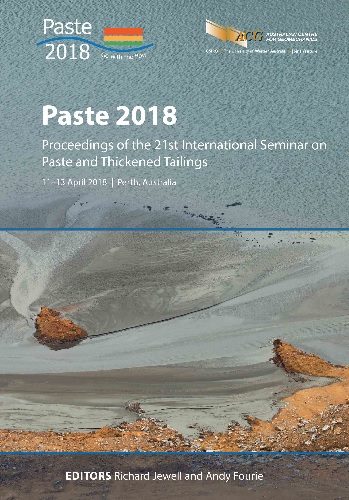Tailings transport on high yield stress requirements: turbulent or laminar flow?

|
Authors: Yánez, R; Tapia, C |
DOI https://doi.org/10.36487/ACG_rep/1805_17_Yanez
Cite As:
Yánez, R & Tapia, C 2018, 'Tailings transport on high yield stress requirements: turbulent or laminar flow?', in RJ Jewell & AB Fourie (eds), Paste 2018: Proceedings of the 21st International Seminar on Paste and Thickened Tailings, Australian Centre for Geomechanics, Perth, pp. 217-226, https://doi.org/10.36487/ACG_rep/1805_17_Yanez
Abstract:
In the mining industry, especially in Chile, tailings impoundment projects are tending to update their thickening technology or improve beach slopes due to environmental concerns, water scarcity, capacity restriction or economic variables. Projects in Chile either being designed or in operation under the concept of high-density tailings do not exceed a yield stress (fully sheared) of approximately 40–50 Pa, and their tailings transport systems may operate in turbulent regimes. There are currently significant research and development projects to improve thickening technology, impoundment deposition strategies and beach slopes management. However, do we have sufficient information and criteria relating to the long distance and large pipeline diameter for the transportation of tailings between the thickening and deposition points for high yield stress requirements? What happens to the transportation of tailings if it must be designed under the concept of high density with a yield stress (fully sheared) above 40–50 Pa but still cannot be considered a paste tailings? Can we expend efforts in thickening and depositing if we do not adequately handle what happens in between (transport)? Generally, for high-density tailings, transportation is designed to operate under the concept of turbulent flow. However, at yield stress above 40–50 Pa, turbulent flow will mean excessive internal wear on the pipelines, due to high velocities and a significant energy demand. What should the criteria be that govern the tailings transport for the high-density zone above 40–50 Pa? Design under turbulent regime or laminar regime? The paper will present an analysis of studies developed to date, identifying and evaluating the variables that govern the design of high-density transport systems within the proposed yield stress ranges. A technical and economic case will be evaluated for a tailings transport project on the proposed yield stress ranges, showing the differences that may exist based on the assumed criteria. The criteria and results of the analysis will be presented in this paper.
Keywords: tailings transport, high-density tailings, turbulent regime, laminar regime
References:
Govier, GW & Aziz, K 1972, The Flow of Complex Mixtures in Pipes, Van Nostrand Reinhold, New York.
Slatter, PT & Wasp, EJ 2000, ‘The laminar/turbulent transition in large pipes’, in J Sabota (ed.), Proceedings of the 10th International Conference on Transport and Sedimentation of Solid Particles, BHR Group, Cranfield, pp. 389–399.
Wilson, KC, Addie, GR, Sellgren, A & Clift, R 2010, Slurry Transport Using Centrifugal Pumps, Springer Publishing, New York.
Wilson, KC & Thomas, AD 1985, ‘A new analysis of the turbulent flow of non-newtonian liquids’, The Canadian Journal of Chemical Engineering, vol. 63, no. 4, pp. 539–546.
© Copyright 2025, Australian Centre for Geomechanics (ACG), The University of Western Australia. All rights reserved.
View copyright/legal information
Please direct any queries or error reports to repository-acg@uwa.edu.au
View copyright/legal information
Please direct any queries or error reports to repository-acg@uwa.edu.au



